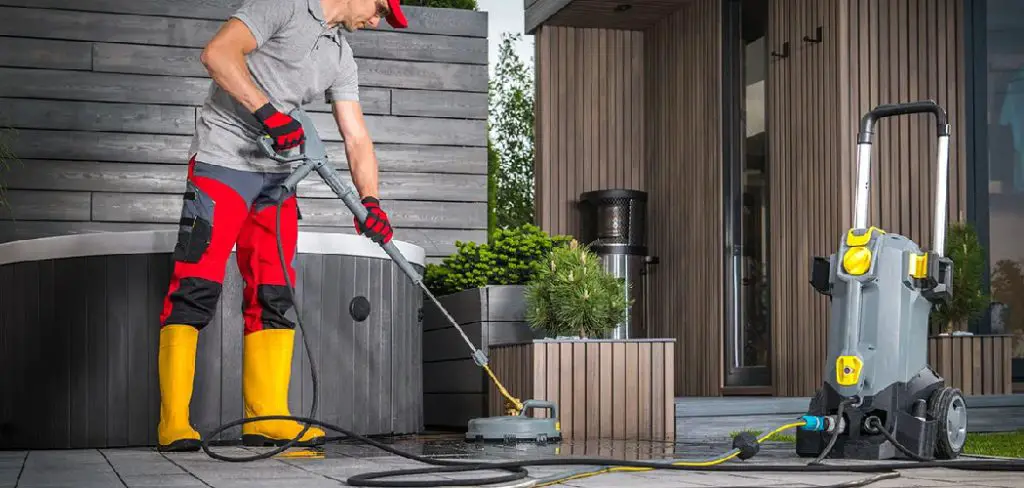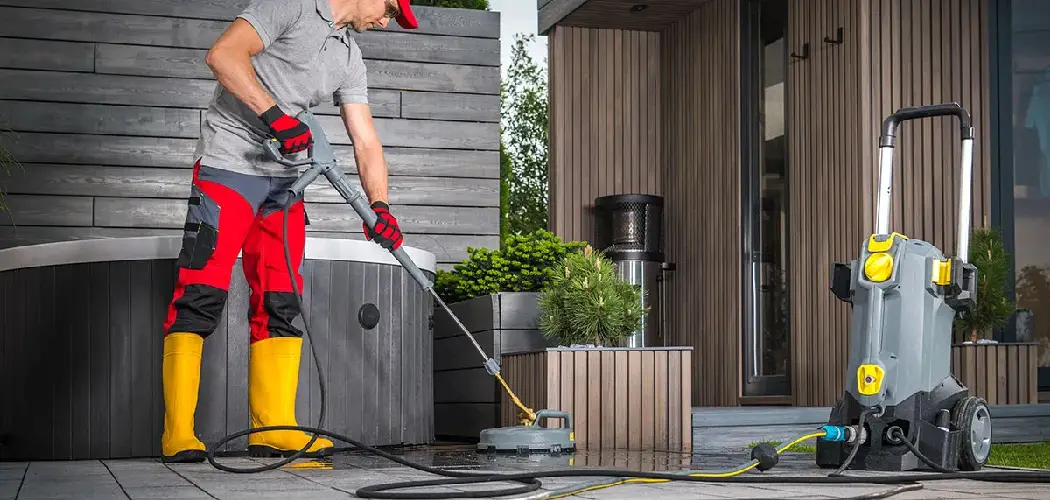To even out a concrete patio, you will need to use a self-leveling compound. This mixture can be poured onto the surface and will automatically level itself to create a smooth finish.
Concrete patios are an excellent addition to any backyard space, but they can become uneven and pose tripping hazards. Fortunately, the solution to this problem is straightforward and can be achieved through the use of a self-leveling compound. This mixture can be poured onto the surface, where it will spread and level out on its own, creating an even and smooth finish.
It’s essential to ensure that the patio is clean and free of any debris before pouring the compound to promote proper adhesion. This guide will walk you through the steps to even out your concrete patio quickly and easily.

Understanding The Benefits Of A Level Concrete Patio
A patio is an excellent addition to any outdoor space, providing the ideal location for gatherings with friends and family or even relaxing on your own. However, a patio that is not level can be frustrating to use, and it can also be a safety hazard.
Here are some benefits of even out your concrete patio:
Weather-Proofing
A level concrete patio can help prevent water from pooling on the surface when it rains. This will help to avoid slip hazards and keep your furniture and other outdoor items dry. Additionally, by having a smooth surface, you’ll be able to easily sweep off any debris.
- Bullet point: Even concrete surface eliminates the risk of water pools forming on the patio.
- Bullet point: Keeping outdoor furniture and items dry by avoiding slip hazards.
- Bullet point: Easy to clean dirt, debris, and maintain.
Aesthetics
An even concrete patio contributes to a uniform and clean appearance in your backyard. It also gives a modern and sleek look, adding value to your home’s exterior. Furthermore, it provides a great foundation for decorating with outdoor rugs, plants, and furniture, making it a more comfortable and inviting space.
- Bullet point: Sleek, modern design.
- Bullet point: Adds value to your home’s exterior.
- Bullet point: Offers more decorating choices.
Added Home Value
Whether you plan on selling your home or not, having a level concrete patio can significantly impact the property’s value. A flat and aesthetically pleasing patio adds a unique selling point to a prospective buyer who might be on the fence.
- Bullet point: Attracts potential buyers to your property.
- Bullet point: One of the most used areas increasing the functionality of the home.
- Bullet point: Aesthetics perception increases the perceived value in their heads.
By leveling a sloping patio, you’re improving the longevity of its overall health, adding beauty and value to your home, and making it an inviting and comfortable outdoor space. Take these benefits into account before you begin to even out your concrete patio.
Common Causes Of Uneven Concrete Patios
Whether you have recently noticed an uneven concrete patio or just installed a new one, it is essential to understand the root causes of the unevenness of your patio. This understanding will help you avoid having a similar problem in the future.
Ground Settling And Shifting
The ground’s shifting and settling is one of the most common causes of an uneven concrete patio. Several factors can lead to ground shifting, including:
- Erosion: This occurs when water or wind displaces soil from under your patio and leads to the unevenness of the patio.
- Tree roots: Trees planted too close to the patio can extend roots under the concrete slab and cause it to shift or crack, leading to unevenness.
- Geological factors: If the land on which your patio is built is naturally uneven, settling and shifting will inevitably lead to an uneven concrete patio.
Poor Initial Installation
Faulty installation of the concrete slab can lead to an uneven patio. The primary cause of poorly installed concrete is the use of inadequate concrete support during the initial installation process. The support should be both correctly positioned and compressed as it is essential to ensure the patio is level.
Other causes of poor installation include:
- Incorrect grading: The ground beneath the patio should be properly graded before starting the installation process. This grading helps prevent drainage problems that can lead to an uneven patio.
- Inconsistent concrete thickness: Installing a slab with mixed thickness can lead to an uneven patio.
Wear And Tear Over Time
Over time, concrete patios can become uneven due to wear and tear. Some of the factors that contribute to this include:
- Thermal expansion and contraction: Periods of extreme temperature fluctuations can cause expansion and contraction, which can weaken the concrete slab and lead to cracks or shifts in the slab.
- Heavy usage: Heavy patio usage or loads that exceed the design load limits can result in concrete warping and cracking.
- Age: Concrete patios have a lifespan, and with age, they tend to become susceptible to wear and tear, leading to an uneven surface.
Understanding the primary causes of an uneven patio will help you prevent future issues and ensure that your patio remains level for years to come. Regular maintenance and upkeep of the slab, as well as the use of high-quality materials during installation, can prolong the patio’s life and prevent significant problems.
Essential Tools And Materials For A Diy Patio Leveling Project
If you have a concrete patio that is uneven or sloping, it can be challenging to enjoy your outdoor space without feeling off-balance. Fortunately, with the right tools and materials, you can level your concrete patio and create a level surface for your outdoor furniture and activities.
We will go over the essential tools and materials you will need for your diy patio leveling project.
Safety Gear
Before starting any diy project, safety should always come first. Here are some of the safety gear you should wear when leveling your concrete patio:
- Safety goggles
- Work gloves
- Dust masks or respiratory protection
- Sturdy work boots with slip-resistant soles
Leveling Compound
Using a leveling compound is one of the easiest ways to level your concrete patio. Here are some key points to remember about leveling compound:
- Choose a leveling compound that is appropriate for outdoor use.
- Follow the manufacturer’s instructions carefully.
- Apply the compound using a trowel or a long, straight edge.
- Allow the compound to dry for at least 24 hours before walking or placing furniture on it.
Concrete Blocks Or Pavers
If you need to raise one side of the patio, concrete blocks, or pavers can be an easy and affordable solution. Here are some things to keep in mind when using concrete blocks or pavers:
- Choose pavers or blocks that are thick enough to raise your patio to the desired height.
- Make sure the surface area of the pavers or blocks that will come into direct contact with the ground is stable and level.
- Lay the blocks or pavers on a bed of mortar to secure them in place.
- Be sure to allow the mortar to dry completely before using your patio.
Shovel
A shovel is an essential tool when leveling concrete patios. Here are some tips to keep in mind when using a shovel:
- Select a sturdy shovel with a comfortable grip.
- Use the shovel to remove any loose dirt or debris on your patio before beginning.
- Gently dig into the uneven parts of the patio and remove excess concrete.
- Use the shovel to collect and dispose of excess concrete safely.
Measuring Tape
Measuring tape is an essential tool that will help you gauge the levelness of your patio. Here are some things to remember when using a measuring tape:
- Always use a level when measuring.
- Record your measurements accurately.
- Use measurements to calculate the amount of leveling compound or blocks/pavers you will need.
By using the above tools and materials, you can level an uneven concrete patio. Remember to prioritize your safety and take your time to ensure your patio is leveled correctly. Enjoy your new, perfectly level outdoor space!
Step-By-Step Guide To Leveling Your Concrete Patio
If your concrete patio surface is uneven, leveling it can help reduce tripping hazards and create a smoother surface for your outdoor activities. Here’s a step-by-step guide to help you level your concrete patio:
Preparing The Patio Surface
Before you can begin leveling your concrete patio, you need to prepare the surface properly. Here’s what you’ll need to do:
- Clean the surface: Sweep or power wash the concrete surface to remove any dirt, debris, or loose concrete.
- Inspect for cracks: Look for any cracks in the concrete surface and repair them before proceeding to ensure a level surface.
- Assess the slope: Use a level to check the slope of the patio and determine which areas require more leveling compound.
Applying The Leveling Compound
Once you have prepared the patio surface, it’s time to apply the leveling compound. Follow these steps:
- Mix the compound: Mix the leveling compound according to the manufacturer’s instructions.
- Apply the compound: Using a trowel, spread the leveling compound over low areas of the concrete surface.
- Smooth the compound: Use a straightedge or trowel to smooth out the compound and create a level surface.
- Allow to dry: Let the leveling compound dry according to the manufacturer’s instructions.
Laying Concrete Blocks Or Pavers
If the slope of your patio is particularly steep, you may need to lay concrete blocks or pavers. Follow these steps:
- Determine location: Decide where you need to add concrete blocks or pavers to create a level surface.
- Lay blocks or pavers: Place concrete blocks or pavers at the necessary location, making sure they are level with the surrounding surface.
- Add dry mix: Fill in the gaps between blocks or pavers with dry mix to create a level surface.
Checking The Patio For Drainage And Slope
Once you have completed leveling the concrete surface, it’s important to ensure proper drainage and slope. Here’s what you need to do:
- Check drainage: Evaluate if water flows towards the correct drainage system and away from your building foundation.
- Confirm slope: Use a level to confirm that the concrete patio is sloping away from the building foundation.
A level surface is key to enjoying your outdoor space fully, so follow this guide to bring balance to your concrete patio surface.
Frequently Asked Questions For How To Even Out Concrete Patio
How Can I Tell If My Concrete Patio Needs To Be Leveled?
You can tell if your concrete patio needs to be leveled if there are visible high and low spots. If water collects in certain areas or if the patio is uneven and poses a tripping hazard.
What Tools Do I Need To Level My Concrete Patio?
You’ll need at least a concrete grinder, concrete leveler and finishing trowel. Additionally, a broom, pressure washer, mixing drill, and wheelbarrow may be necessary.
Can I Level Concrete Patio By Myself?
Yes, you can level a concrete patio by yourself using the right tools and techniques. However, if you’re unsure about your skills, it’s better to contact a professional contractor.
How Long Does It Take To Even Out A Concrete Patio?
The time it takes to even out a concrete patio depends on the size and level of damage. Typically, it can take from a couple of days to a week to complete the leveling process.
Is It Necessary To Seal My Leveled Concrete Patio?
Yes, it’s necessary to seal your leveled concrete patio to protect it against moisture, stains, and wear. Use a concrete sealer that is suitable for your patio and provides long-lasting protection.
How Much Does It Cost To Level A Concrete Patio?
The cost of leveling a concrete patio varies based on the size and condition of the patio. However, the average cost can range from $500 to $1,000 for a 100-square-foot patio.
Conclusion
After reading this blog post, we hope that you’ve gained a better understanding of how to even out concrete patios. Whether you choose to use a self-leveling compound or a diy method, the key is to properly prepare the surface and follow the instructions carefully.
Remember that safety should always come first, wear appropriate personal protective equipment, and work in a well-ventilated area. A level concrete patio not only looks great but also provides a functional and safe outdoor living space for your family and friends.
Don’t forget to regularly clean and maintain your patio, which will ensure its longevity and keep it looking its best. By following these tips, your concrete patio will be a source of pride for years to come.

